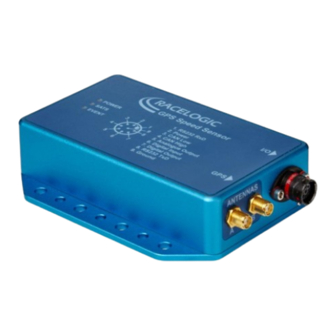Advertisement
Quick Links
Dual Antenna VBOX Speed Sensors
https://en.racelogic.support//Product_Info/Sensors/Single_and_Dual_Antenna_Speed_Sensors/
Knowledge_Base/Dual-antenna_Speed_Sensors
The Dual Antenna VBOX Speed Sensor (VBSS100SL) is a high-accuracy, 100 Hz, GPS/GLONASS
system. It combines high-level accuracy and test repeatability with the ability to measure slip and pitch/roll
angles at 100 Hz.
The VBSS100SL package includes VBOX Manager, which enables the user to set up the dual antenna separation,
change the dynamic modes and level and align the antennas.
You can use the Dual Antenna BOX Speed Sensor straight from the box. It will output digital and analogue signals
according to the default settings. You can change these settings in the
here.
Mounting
The Dual Antenna VBOX Speed Sensor should be securely mounted inside the vehicle, level with the ground. There are
holes in the ground plate that can be used to fasten the Speed Sensor to a suitable location in the vehicle. Make sure
that the surface with the LEDs and pin information is up.
Antenna Placement
Even though installing and using the Dual Antenna VBOX Speed Sensor is intended to be fast and simple, you must pay
careful attention to the placement of the antennas.
Antenna A is the primary antenna, on which all calculations are based. You should place the primary antenna relative to
where you wish to take your measurements. For example, if you wish to make measurements from the centre of the
vehicle, you achieve this by placing the primary antenna at the centre of the vehicle or translating the position using the
slip angle translation function in VBOX Manager.
The measured distance between the antennas should be the straight-line distance between the antennas regardless of
VBOX Setup
Software. Learn how to do this
1
Advertisement

Summary of Contents for Racelogic VBSS100SL
- Page 1 It combines high-level accuracy and test repeatability with the ability to measure slip and pitch/roll angles at 100 Hz. The VBSS100SL package includes VBOX Manager, which enables the user to set up the dual antenna separation, change the dynamic modes and level and align the antennas.
- Page 2 You can purchase a mating connector, Deutsch ASDD606-09PN, from Racelogic for this purpose. You should connect the GNSS antenna before you connect power to the Speed Sensor. This is because the Speed Sensor will look for a connected GNSS antenna and automatically adjust its gain for optimum performance from the connected antenna.
- Page 3 This has an internal ground plane and can operate perfectly without the need to be mounted on a metal surface. Ground plane antennas are available from your Racelogic distributor. Media, iframe, embed and object tags are not supported inside of a PDF.
-
Page 4: Gps Coldstart
temporarily obscuring the signal from satellites at low elevation. Raising the mask will cause the GPS engine to ignore satellites below the mask angle. You must use it carefully, though, as it also reduces the total number of received satellites. You can change the elevation mask angle under the GPS tab in the VBOX Setup Software or by using a VBOX Manager. - Page 6 3. When this is done correctly, the LEDs on the Speed Sensor will all turn red before returning to normal function when the coldstart procedure has been completed. Setup Racelogic developed the VBOX Manager to control the operating functions of a Dual Antenna VBOX Speed Sensor. This section describes how to set up your vehicle with two antennas. Menu In the 'Dual Antenna' menu, select 'Dual Antenna Mode', scroll to 'Enable' and confirm.
-
Page 7: Antenna Separation
Antenna Separation The most important factor for dual-antenna testing is the correct configuration of the separation distance between the two antenna centre points. This allows the Speed Sensor to acquire and maintain the dual-antenna lock. You need to measure the physical separation distance between the two antennas, as accurately as possible, and enter it into the Separation option in the Dual Antenna menu. -
Page 8: Align Antennas
Align Antennas To measure the slip angle with the most accurate precision, try to get the alignment of the antennas as close as possible to the centre line of the vehicle. You can remove residual errors in the alignment with the 'Auto Align' feature in VBOX Manager. - Page 9 The calibration process requires you to drive in a straight line for a short period of time, while maintaining a constant speed, which must be greater than 25 km/h. Note: You need to remove any existing alignment offset from the previous setup by using the 'Clear' function. This must be completed before you start the Auto Align function.
- Page 10 Selecting 'Clear' option will remove any offset applied to the pitch channel. Slip Angle Translation In Dual Antenna mode you may wish to take slip measurements from other locations on the vehicle, for instance the centre of gravity or the slip over the wheels. You can set this by using the Slip Translation function in VBOX Manager. The five additional locations are set using Ahead/Behind and Left/Right offsets from the primary antenna location (antenna 1 in the picture below).
- Page 11 In section 1 on the diagram below, you can see a Left offset between the primary antenna and the target area for slip measurement. Same again for section 2, you can see an Ahead offset. You will need to apply these offsets with the VBOX Manager.




Need help?
Do you have a question about the VBSS100SL and is the answer not in the manual?
Questions and answers